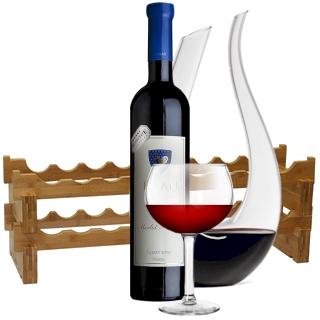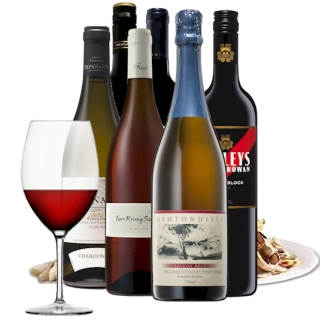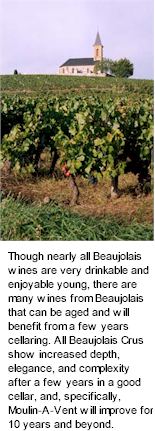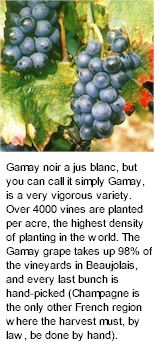


Vines have been growing in Beaujolais since the second or third century, as attested by various writings. What is certain is that Beaujolas owes its name to the Sires of Beaujeu, who reigned over a large and important territory from the 9th to 11th centuries. In 1400, Edouard de Beaujeu gave his lands to the Bourbon. Pierre de Bourbon married Anne de France, Louis XI's daughter, who became known as Anne de Beaujeu and was the Regent of France. She bestowed her patronage on the town of Villefranche, and in 1514 Villefranche was designated the new capital of the Beaujolais.

Fast-forward to the 21st century, when the first Appellations d'Origine Controlle (AOC) of Beaujolais were created: Beaujolais, Beaujolais Villages, Brouilly, Cote de Brouilly, Regnie, Morgon, Chiroubles, Fleurie, Moulin-a-Vent, Chenas, Julienas Later, Saint Amour was granted AOC status (in 1946), and most recently (in 1988) Regnie gained status as an AOC. The vineyards in the Beaujolais region spread out over 30 miles from north to south and 8 miles across, bordered by Maconnais to the north, the Rhone Valley to the south, and the river Saone to the east. The vineyards in northern Beaujolais have a predominance of granite, which gives aromas of ripe fruit and faded rose. In the south, a clay-limestone soil gives a bouquet of red fruits.
The way to make Beaujolais wine is slightly different from making other wines. Carbonic Maceration is the name of the fermentation technique used to make Beaujolais. First, whole bunches of grapes are placed in the vats, and the weight of the fruit begins to crush the bottom one-third of the grape clusters. Fermentation begins when naturally occurring yeasts consume the grape’s sugar and create alcohol and carbon dioxide (CO2). The carbon dioxide then envelops the remaining two-thirds of the grape clusters, which allows intracellular fermentation to occur within the whole grapes – the grapes actually ferment inside their own skins! Carbonic Maceration lasts four days for Beaujolais Nouveau, 6 - 8 days for Beaujolais and Beaujolais Villages and up to 10 days for Cru Beaujolais.
A central issue in wine growing is controlling the yield of each vine, and winegrowers use pruning systems to control yields. There are two pruning systems practiced in Beaujolais: the Guyot and the Gobelet. The Guyot-trained vines in Beaujolais will result in larger grapes, so that wines will be fruity and light, while the Gobelet-trained vines in Beaujolais Villages and the Crus produce smaller, more concentrated grapes (and thus, more concentrated wines).

Duboeuf Beaujolais is a joyous wine, full of charm and fruit. The reduced yields demanded by Duboeuf in the vineyard create a wine that is full of the juicy fruit forward flavors that Beaujolais is known for, with greater structure and concentration. Bright ruby-red in color, this wine is bursting with red fruit aromas, interweaving strawberries, raspberries and red currants with the scent of flowers. Supple and harmonious in the mouth, the red fruit carries through until the finish. Georges Duboeuf Beaujolais is pure pleasure in the glass, the quintessential summer wine, full of flavor to match with any and all summer faire.
The great thing about Duboeuf Beaujolais is while the wine tastes great at room temperature, it’s even more delicious chilled. Putting a bottle in the refrigerator will enhance the crisp, refreshing red berry flavors that are so prevalent in Georges Duboeuf’s Beaujolais. And if you’re sitting out back with friends, eating dinner hot off the grill, keep the wine chilled on ice by grabbing an ice bucket or a sand pail if it’s closer. For summer entertaining, it’s all about fun and relaxation.
Chilled wine is nothing new for wine lovers. But when the heat is unbearable, people tend to go straight for the white. This summer, why not reach for Georges Duboeuf Beaujolais, the red wine you can chill. Beaujolais is perfect to rescue you from an all-white wine and beer summer, and has more complex flavors than most whites.
Duboeuf Beaujolais is surprisingly versatile and goes well with everything from smoked chicken and grilled fish to hamburgers on the grill. According to Georges Duboeuf, this chillable red “has beautiful aromas of black currant and strawberry. The round taste is quite rich and very pleasant to the palate.” Beaujolais, made from 100% Gamay grapes, has thinner skins than other varietals, causing the tannin levels to be lower, resulting in a wine that tastes delicious when chilled. Duboeuf Beaujolais is full of supple flavors with just the right combination of fruit and acidity making this cool red a pleasure on the palate.
